Li Zhao
Senior Member, IEEE
villa-X: Enhancing Latent Action Modeling in Vision-Language-Action Models
Jul 31, 2025Abstract:Visual-Language-Action (VLA) models have emerged as a popular paradigm for learning robot manipulation policies that can follow language instructions and generalize to novel scenarios. Recent work has begun to explore the incorporation of latent actions, an abstract representation of visual change between two frames, into VLA pre-training. In this paper, we introduce villa-X, a novel Visual-Language-Latent-Action (ViLLA) framework that advances latent action modeling for learning generalizable robot manipulation policies. Our approach improves both how latent actions are learned and how they are incorporated into VLA pre-training. Together, these contributions enable villa-X to achieve superior performance across simulated environments including SIMPLER and LIBERO, as well as on two real-world robot setups including gripper and dexterous hand manipulation. We believe the ViLLA paradigm holds significant promise, and that our villa-X provides a strong foundation for future research.
PIG-Nav: Key Insights for Pretrained Image Goal Navigation Models
Jul 23, 2025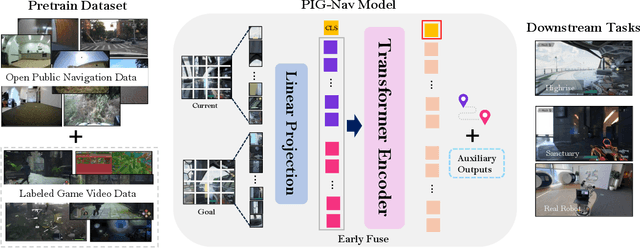

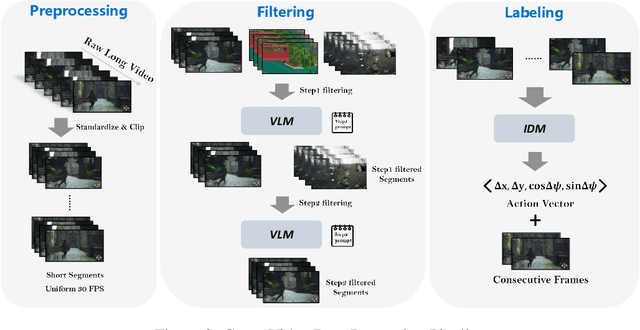

Abstract:Recent studies have explored pretrained (foundation) models for vision-based robotic navigation, aiming to achieve generalizable navigation and positive transfer across diverse environments while enhancing zero-shot performance in unseen settings. In this work, we introduce PIG-Nav (Pretrained Image-Goal Navigation), a new approach that further investigates pretraining strategies for vision-based navigation models and contributes in two key areas. Model-wise, we identify two critical design choices that consistently improve the performance of pretrained navigation models: (1) integrating an early-fusion network structure to combine visual observations and goal images via appropriately pretrained Vision Transformer (ViT) image encoder, and (2) introducing suitable auxiliary tasks to enhance global navigation representation learning, thus further improving navigation performance. Dataset-wise, we propose a novel data preprocessing pipeline for efficiently labeling large-scale game video datasets for navigation model training. We demonstrate that augmenting existing open navigation datasets with diverse gameplay videos improves model performance. Our model achieves an average improvement of 22.6% in zero-shot settings and a 37.5% improvement in fine-tuning settings over existing visual navigation foundation models in two complex simulated environments and one real-world environment. These results advance the state-of-the-art in pretrained image-goal navigation models. Notably, our model maintains competitive performance while requiring significantly less fine-tuning data, highlighting its potential for real-world deployment with minimal labeled supervision.
AdaptiveStep: Automatically Dividing Reasoning Step through Model Confidence
Feb 19, 2025Abstract:Current approaches for training Process Reward Models (PRMs) often involve breaking down responses into multiple reasoning steps using rule-based techniques, such as using predefined placeholder tokens or setting the reasoning step's length into a fixed size. These approaches overlook the fact that specific words do not typically mark true decision points in a text. To address this, we propose AdaptiveStep, a method that divides reasoning steps based on the model's confidence in predicting the next word. This division method provides more decision-making information at each step, enhancing downstream tasks, such as reward model learning. Moreover, our method does not require manual annotation. We demonstrate its effectiveness through experiments with AdaptiveStep-trained PRMs in mathematical reasoning and code generation tasks. Experimental results indicate that the outcome PRM achieves state-of-the-art Best-of-N performance, surpassing greedy search strategy with token-level value-guided decoding, while also reducing construction costs by over 30% compared to existing open-source PRMs. In addition, we provide a thorough analysis and case study on the PRM's performance, transferability, and generalization capabilities.
COMPrompter: reconceptualized segment anything model with multiprompt network for camouflaged object detection
Nov 28, 2024Abstract:We rethink the segment anything model (SAM) and propose a novel multiprompt network called COMPrompter for camouflaged object detection (COD). SAM has zero-shot generalization ability beyond other models and can provide an ideal framework for COD. Our network aims to enhance the single prompt strategy in SAM to a multiprompt strategy. To achieve this, we propose an edge gradient extraction module, which generates a mask containing gradient information regarding the boundaries of camouflaged objects. This gradient mask is then used as a novel boundary prompt, enhancing the segmentation process. Thereafter, we design a box-boundary mutual guidance module, which fosters more precise and comprehensive feature extraction via mutual guidance between a boundary prompt and a box prompt. This collaboration enhances the model's ability to accurately detect camouflaged objects. Moreover, we employ the discrete wavelet transform to extract high-frequency features from image embeddings. The high-frequency features serve as a supplementary component to the multiprompt system. Finally, our COMPrompter guides the network to achieve enhanced segmentation results, thereby advancing the development of SAM in terms of COD. Experimental results across COD benchmarks demonstrate that COMPrompter achieves a cutting-edge performance, surpassing the current leading model by an average positive metric of 2.2% in COD10K. In the specific application of COD, the experimental results in polyp segmentation show that our model is superior to top-tier methods as well. The code will be made available at https://github.com/guobaoxiao/COMPrompter.
DanceFusion: A Spatio-Temporal Skeleton Diffusion Transformer for Audio-Driven Dance Motion Reconstruction
Nov 07, 2024



Abstract:This paper introduces DanceFusion, a novel framework for reconstructing and generating dance movements synchronized to music, utilizing a Spatio-Temporal Skeleton Diffusion Transformer. The framework adeptly handles incomplete and noisy skeletal data common in short-form dance videos on social media platforms like TikTok. DanceFusion incorporates a hierarchical Transformer-based Variational Autoencoder (VAE) integrated with a diffusion model, significantly enhancing motion realism and accuracy. Our approach introduces sophisticated masking techniques and a unique iterative diffusion process that refines the motion sequences, ensuring high fidelity in both motion generation and synchronization with accompanying audio cues. Comprehensive evaluations demonstrate that DanceFusion surpasses existing methods, providing state-of-the-art performance in generating dynamic, realistic, and stylistically diverse dance motions. Potential applications of this framework extend to content creation, virtual reality, and interactive entertainment, promising substantial advancements in automated dance generation. Visit our project page at https://th-mlab.github.io/DanceFusion/.
Hard Prompts Made Interpretable: Sparse Entropy Regularization for Prompt Tuning with RL
Jul 20, 2024Abstract:With the advent of foundation models, prompt tuning has positioned itself as an important technique for directing model behaviors and eliciting desired responses. Prompt tuning regards selecting appropriate keywords included into the input, thereby adapting to the downstream task without adjusting or fine-tuning the model parameters. There is a wide range of work in prompt tuning, from approaches that directly harness the backpropagated gradient signals from the model, to those employing black-box optimization such as reinforcement learning (RL) methods. Our primary focus is on RLPrompt, which aims to find optimal prompt tokens leveraging soft Q-learning. While the results show promise, we have observed that the prompts frequently appear unnatural, which impedes their interpretability. We address this limitation by using sparse Tsallis entropy regularization, a principled approach to filtering out unlikely tokens from consideration. We extensively evaluate our approach across various tasks, including few-shot text classification, unsupervised text style transfer, and textual inversion from images. The results indicate a notable improvement over baselines, highlighting the efficacy of our approach in addressing the challenges of prompt tuning. Moreover, we show that the prompts discovered using our method are more natural and interpretable compared to those from other baselines.
Exploring Deeper! Segment Anything Model with Depth Perception for Camouflaged Object Detection
Jul 17, 2024


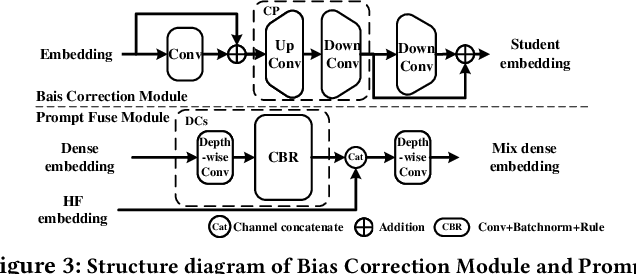
Abstract:This paper introduces a new Segment Anything Model with Depth Perception (DSAM) for Camouflaged Object Detection (COD). DSAM exploits the zero-shot capability of SAM to realize precise segmentation in the RGB-D domain. It consists of the Prompt-Deeper Module and the Finer Module. The Prompt-Deeper Module utilizes knowledge distillation and the Bias Correction Module to achieve the interaction between RGB features and depth features, especially using depth features to correct erroneous parts in RGB features. Then, the interacted features are combined with the box prompt in SAM to create a prompt with depth perception. The Finer Module explores the possibility of accurately segmenting highly camouflaged targets from a depth perspective. It uncovers depth cues in areas missed by SAM through mask reversion, self-filtering, and self-attention operations, compensating for its defects in the COD domain. DSAM represents the first step towards the SAM-based RGB-D COD model. It maximizes the utilization of depth features while synergizing with RGB features to achieve multimodal complementarity, thereby overcoming the segmentation limitations of SAM and improving its accuracy in COD. Experimental results on COD benchmarks demonstrate that DSAM achieves excellent segmentation performance and reaches the state-of-the-art (SOTA) on COD benchmarks with less consumption of training resources. The code will be available at https://github.com/guobaoxiao/DSAM.
Video In-context Learning
Jul 10, 2024Abstract:In-context learning for vision data has been underexplored compared with that in natural language. Previous works studied image in-context learning, urging models to generate a single image guided by demonstrations. In this paper, we propose and study video in-context learning, where the model starts from an existing video clip and generates diverse potential future sequences, each semantically guided by the prompted video demonstrations. To achieve this, we provide a clear definition of the task, and train an autoregressive Transformer on video datasets. We thoroughly analyze the effect of different datasets and represent frames as discrete tokens, and then model them by next token predictions. We design various evaluation metrics, including both objective and subjective measures, to demonstrate the visual quality and semantic accuracy of generation results. Our model follows the scaling law and generates high-quality video clips that accurately align with the semantic guidance provided by in-context examples.
DPO Meets PPO: Reinforced Token Optimization for RLHF
Apr 29, 2024



Abstract:In the classical Reinforcement Learning from Human Feedback (RLHF) framework, Proximal Policy Optimization (PPO) is employed to learn from sparse, sentence-level rewards -- a challenging scenario in traditional deep reinforcement learning. Despite the great successes of PPO in the alignment of state-of-the-art closed-source large language models (LLMs), its open-source implementation is still largely sub-optimal, as widely reported by numerous research studies. To address these issues, we introduce a framework that models RLHF problems as a Markov decision process (MDP), enabling the capture of fine-grained token-wise information. Furthermore, we provide theoretical insights that demonstrate the superiority of our MDP framework over the previous sentence-level bandit formulation. Under this framework, we introduce an algorithm, dubbed as Reinforced Token Optimization (\texttt{RTO}), which learns the token-wise reward function from preference data and performs policy optimization based on this learned token-wise reward signal. Theoretically, \texttt{RTO} is proven to have the capability of finding the near-optimal policy sample-efficiently. For its practical implementation, \texttt{RTO} innovatively integrates Direct Preference Optimization (DPO) and PPO. DPO, originally derived from sparse sentence rewards, surprisingly provides us with a token-wise characterization of response quality, which is seamlessly incorporated into our subsequent PPO training stage. Extensive real-world alignment experiments verify the effectiveness of the proposed approach.
Empowering Large Language Models on Robotic Manipulation with Affordance Prompting
Apr 17, 2024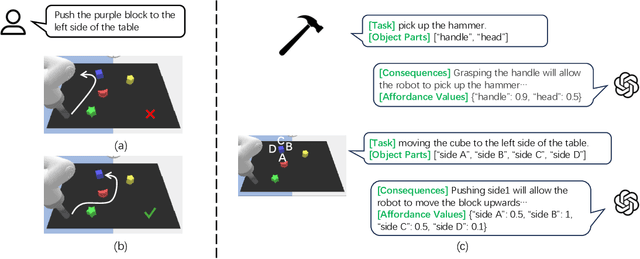
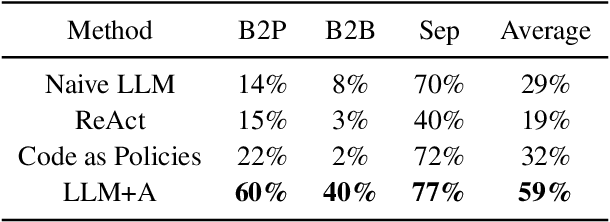
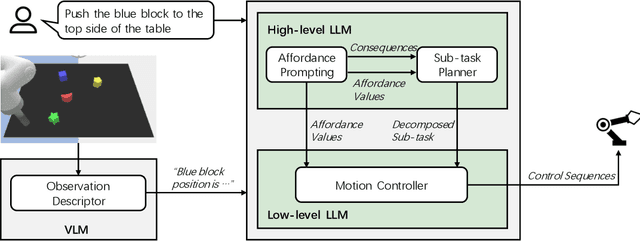
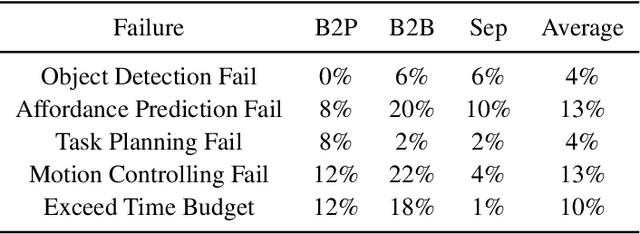
Abstract:While large language models (LLMs) are successful in completing various language processing tasks, they easily fail to interact with the physical world by generating control sequences properly. We find that the main reason is that LLMs are not grounded in the physical world. Existing LLM-based approaches circumvent this problem by relying on additional pre-defined skills or pre-trained sub-policies, making it hard to adapt to new tasks. In contrast, we aim to address this problem and explore the possibility to prompt pre-trained LLMs to accomplish a series of robotic manipulation tasks in a training-free paradigm. Accordingly, we propose a framework called LLM+A(ffordance) where the LLM serves as both the sub-task planner (that generates high-level plans) and the motion controller (that generates low-level control sequences). To ground these plans and control sequences on the physical world, we develop the affordance prompting technique that stimulates the LLM to 1) predict the consequences of generated plans and 2) generate affordance values for relevant objects. Empirically, we evaluate the effectiveness of LLM+A in various language-conditioned robotic manipulation tasks, which show that our approach substantially improves performance by enhancing the feasibility of generated plans and control and can easily generalize to different environments.
 Add to Chrome
Add to Chrome Add to Firefox
Add to Firefox Add to Edge
Add to Edge